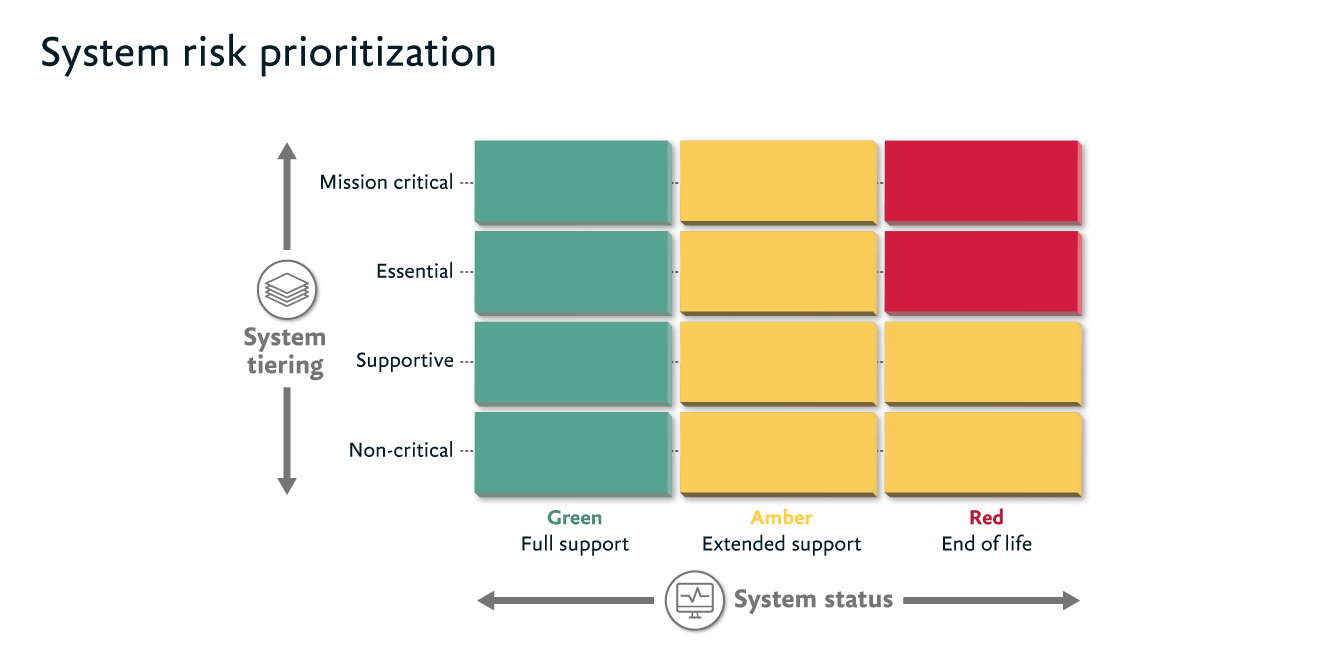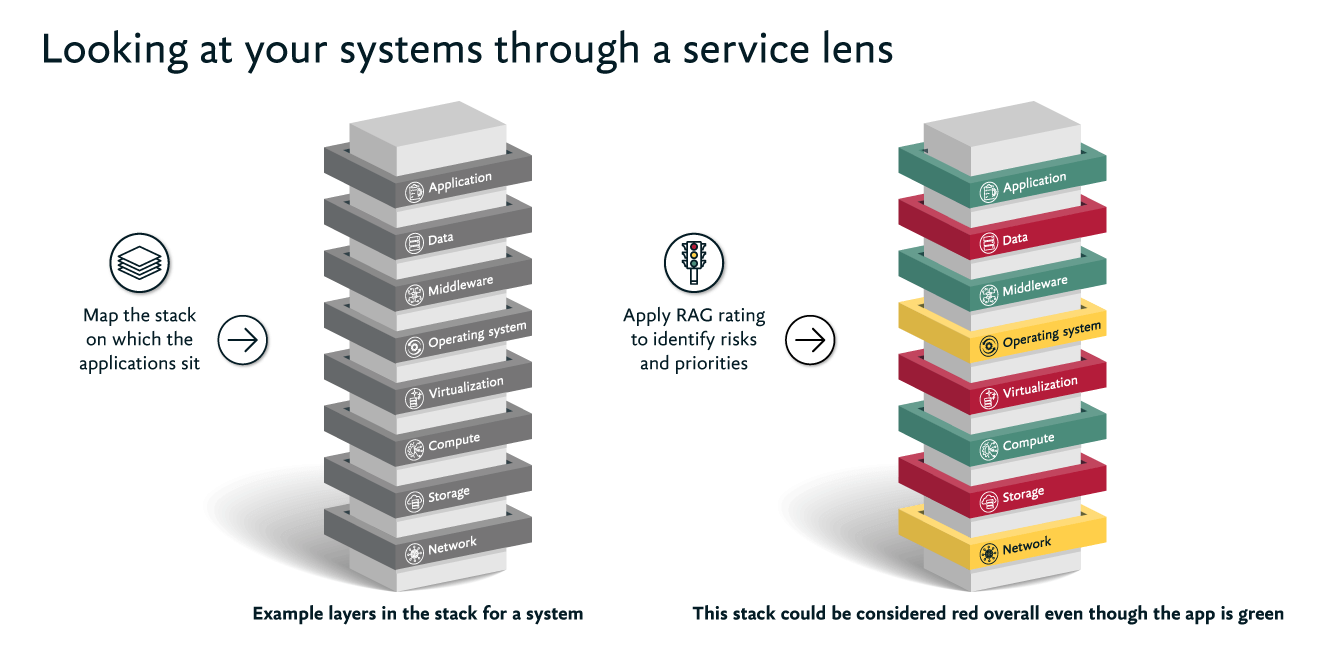How confident are you in the information you’re using to identify the obsolescence risk in your legacy estate and target investment in tech modernization? If you’re less than confident, you’re not alone. How can you ensure you have the right data to identify the most pressing priorities for action and direct tech investment where it really counts?
Reliance on ageing legacy technology is putting operations at risk, draining cash on upkeep and holding back innovation. But you can’t just flick a switch and move over to fully modernized systems. As you grapple with finite investment budgets and the need to keep critical operations running, the big questions are what do you prioritize and when?
Insufficient data for tech modernization
The problem is that most organizations lack the clear, credible and up-to-date data needed to answer these questions. Few organizations know the true size and make-up of their legacy estate, let alone which capabilities are most critical, at most risk of obsolescence and in most urgent need of replacement. Legacy risk is not effectively managed across the public sector and can impact service delivery. The lack of consolidated data on the public sector’s digital and data assets and the scale of legacy could present a challenge to effectively identifying and mitigating risk.
The risks of unreliable data for technology transformation
Without reliable data, you could find yourself firing blind, targeting the wrong systems or pouring precious resources into the latest tech hype. Worse still, you could fail to spot signs of rapid deterioration in ‘mission critical’ capabilities – not just applications but the tech stacks upon which they run. The results would heighten the risks of operational breakdown, customer dissatisfaction or security vulnerabilities. They could also force you into an overly hasty and reactive ‘quick fix’ solution, rather than looking at how the system could be improved or delivered in a more effective way.
Poor data: losing business support
Lack of hard data and poor targeting also come with an opportunity cost. In particular, you risk losing credibility and support from business teams if technology goes wrong or investment in modernization fails to deliver the intended objectives.
Three ways to sharpen investment targeting
So what information do you need to target investment in the most effective way? How can you best source and communicate this crucial data? Three priorities stand out:
In our experience, the key foundations for gauging the obsolescence risks and targeting intervention and investment are:
- Agreed view of the components are most critical to your organization
- Comprehensive and regularly updated assessment of the status of the different components within your technology estate

The criticality evaluation should look at the role and importance of each component and the stack it runs on to deliver your business services and organizational objectives. ‘Mission critical’ components would form the top tier. Below this would be gradually less significant tiers based on business criticality and impact.
The system status evaluation would look at how far the component and supporting infrastructure have come along their useable lifecycle as they progressively move beyond initial contractual support, begin to deteriorate and eventually become too costly and risky to maintain.
By mapping the criticality measure against the systems status, you can create a red, amber and green (RAG) rating to help judge which areas of your tech estate are at greatest risk and in most urgent need of attention.
This early warning system will help you to proactively target interventions and build this into a wider vision for modernization. The RAG ratings would also help to engage leadership and business teams by applying tangible KPIs to the systems risks and demonstrating how deterioration could impact on organizational goals and performance.
The other big advantage of this informed and proactive approach is giving you more time and scope to determine the most appropriate solution. Re-hosting (e.g. moving to the cloud), replacing or rebuilding might be the most effective way to upgrade ‘Code Red’ capabilities in the long run, but it’s also important to think about what you do to limit the obsolescence risks and their impact in the short-term.
Applications don’t exist in a vacuum. Systems are highly interdependent, not just in their tech functionality, but also in the role they play in your operating model and ability to deliver your strategy.
To gauge the obsolescence risks, prioritize investment and build this into longer term modernization, it’s therefore important to adopt a ‘service lens’ by mapping the stack on which the applications sit (operating systems, databases, platforms, networks and hardware) and how the various components interact in delivering critical capabilities.

Your RAG ratings should reflect this joined-up service lens. For example, you may be using the latest app, but the servers and operating systems it runs on are coming to the end of their life.
The other advantage of this service lens is in helping to map applications and supporting systems against organizational priorities. The results will help to inform decisions on the most viable systems architecture and operating model for delivering your ambitions. Key questions include whether it’s best to host or outsource critical functions or whether you need to look at how to use technology differently.
To engage with boards and business teams, it’s important to distil the data into insights that they can understand, relate to and build into their decisions. For example, rather than just giving a RAG rating for obsolescence, you can also provide data on the options to address the impact and what could happen if no action is taken. You could also introduce gamification by comparing the percentage of Code Red RAG ratings across different areas of your organization and communicating this to divisional chiefs.
What gets measured, gets done
What gets measured gets done. The right KPIs will help your organisation and its leadership to quantify the problems and build a credible business case for action.
Further articles in this series look at how to use these data insights to help develop the architecture, delivery model and leadership buy-in needed to modernise your organisation.
Let’s talk
We’re working with businesses across all sectors to help them sustain operations and cut through the complexities of legacy tech transformation. Contact us if you’d like to know more.










